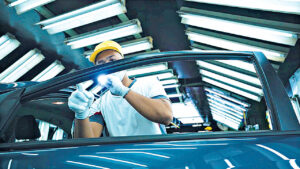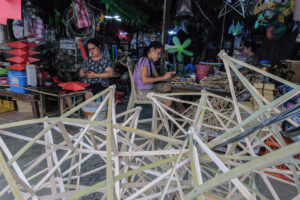
Multiplying the sunrise
A GROWING market is a magnet for investors, much like the proverbial moth to a flame. This is true for businesses in general but is even more so for the automotive sector. Volume leads to economies of scale that are critical to absorb the significantly high fixed costs of research and development inherent to the industry.
Among the ASEAN auto markets, the Philippines is proving to be quite the attraction. Perennial growth markets like Thailand and Indonesia registered a decline last year and this one. To be sure, vehicle sales in the Philippines — reported at 438,000 in 2023 and projected to hit 470,000 units this year — are still quite a ways from the one million units sold in Indonesia last year or even the 775,000 vehicles moved in Thailand. The point is, the Philippine auto market is growing at a highly sustainable pace given the economics and demographics of the country.
We have become a destination for more automakers. Primarily, these new makes are from China, with some European badges and retailers in the mix. The latest buzz is, of course, the reported direct entry of Tesla into the local market. And while fresh players have taken the market by storm, the introduction of new models and technologies have hit car showrooms with a ferocity reserved for super cyclones.
LUXURY OF CHOICEWell and good. In a free market, consumers are best served by having choices — a lot of choices. However, too much of a good thing could eventually become bad. With a highly fragmented industry in a still-emerging sector, market efficiency and productivity might lead to the collapse of some players, leaving those who bought their cars orphaned.
The greater promise of rising auto sales is the prospect of being able to build a local industry around it. There are only two local manufacturers of cars and light commercial vehicles: Toyota and Mitsubishi. There are some truck builders like Hino, Isuzu, and Foton. Toyota has a rated capacity of 54,000 units at its Santa Rosa factory while Mitsubishi’s is 50,000 units. Comparatively, production capacity in all of Thailand was reported by Statista at 1.83 million in 2023. Meantime, a 2024 report by Indonesia Investments showed that installed car production capacity in Indonesia (as of 2017) was at 2.2 million units.
The manufacturing sector of the Philippines needs a major shot in the arm. The National Economic and Development Authority (NEDA) recognizes that the local economy is structurally imbalanced in favor of the service sector. In 2023, the Bangko Sentral ng Pilipinas (BSP) reported that the service sector accounted for 62.4% of GDP. Industry and the agriculture sectors represented only 28.1% and 9.4% of GDP, respectively. From within the industry sector, manufacturing contributed only 16%. While it is crucial to continue nurturing the services sector — revenues of US$35.5 billion by the BPO sector cannot be ignored — expanding the contribution of the manufacturing sector is necessary for sustainable economic growth.
PRODUCTION FOR PROGRESSIn this regard, the automotive sector shows great potential. Because of its strong vertical and horizontal linkages, auto manufacturing results to a strong multiplier effect to the local economy. It also carries with it high levels of fixed investments that result to a higher value addition. It brings stable employment and enables significant technical know-how transfer, too, contributing to higher-value skills. And contributions to government revenues are huge.
In the case of Toyota Motor Philippines (TMP), it sustains a direct workforce of around 4,000 Filipinos. In its entire ecosystem — TMP, suppliers, dealers — Toyota provides jobs for approximately 69,000 Filipinos. From 1988 to 2023, it rolled out 1.1 million units in Santa Rosa (and Bicutan) and sold 2.3 million units through its dealers that now count 74 nationwide. Over the same period, it has remitted to the government taxes and duties of P479 billion, and has enabled exports from the Toyota Group of companies of US$20.2 billion since 1997. Total investments over the more than three decades have reached P30.4 billion.
The government, realizing the importance of the auto sector, instituted the Comprehensive Automotive Resurgence Strategy (CARS) program in 2015. Toyota and Mitsubishi registered, committing to make fixed investments in local parts production and produce 200,000 units of the Vios and Mirage, respectively, over six years. The program brought clear benefits to the country and this strategic approach is needed to assure that the country can leverage its continuing march to motorization.
FOR EVRecently, the government pushed for local production of cars or components relating to electrified mobility. This is a leg-up in the right direction. However, there are a host of countries vying to become production bases, especially as China dominates the sector. Trade barriers, incentives for local production and subsidies for early adoption of electrified vehicles abound. The Philippines has some advantages in the race, such as the availability of needed mineral resources and skilled labor. But more must be offered in areas like cost — and availability — of power, efficiency of logistics, and stability of the regulatory environment.
The promotion of vehicle manufacturing, though, should be an inclusive policy. The government is well-served to sustain and grow local parts and automobile production in general — not just EVs. After all, the transition to electrified mobility is a journey and the shift from ICE-powered cars to BEVs will take many years. In the meantime, we can continue to produce vehicles that will meet the growing mobility needs of the country. Even as EVs grow in number, they will still need body parts, instrument panels, wiring harnesses, door trims, bumpers, and seats. We should find ways to sustain our gains in locally sourcing these parts or, even better, scaling up their production.
At a conservative 5% compounded growth in auto sales, the market will track toward 700,000 units by the early part of the next decade — closer to 800,000 if sales will follow the same trajectory as the economy’s 6% growth in the coming years. This is a great opportunity to position the Philippines strategically in the global automotive supply chain. We must stake our ground.


